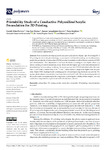Mostrar o rexistro simple do ítem
Printability Study of a Conductive Polyaniline/Acrylic Formulation for 3D Printing
| dc.contributor.author | Arias-Ferreiro, Goretti | |
| dc.contributor.author | Ares-Pernas, Ana | |
| dc.contributor.author | Lasagabáster-Latorre, Aurora | |
| dc.contributor.author | Aranburu, Nora | |
| dc.contributor.author | Guerrica-Echevarria, Gonzalo | |
| dc.contributor.author | Dopico-García, M. Sonia | |
| dc.contributor.author | Abad, María-José | |
| dc.date.accessioned | 2021-07-14T11:07:59Z | |
| dc.date.available | 2021-07-14T11:07:59Z | |
| dc.date.issued | 2021 | |
| dc.identifier.citation | Arias-Ferreiro, G.; Ares-Pernas, A.; Lasagabáster-Latorre, A.; Aranburu, N.; Guerrica-Echevarria, G.; Dopico-García, M.S.; Abad, M.-J. Printability Study of a Conductive Polyaniline/Acrylic Formulation for 3D Printing. Polymers 2021, 13, 2068. https://doi.org/10.3390/polym13132068 | es_ES |
| dc.identifier.issn | 2073-4360 | |
| dc.identifier.uri | http://hdl.handle.net/2183/28199 | |
| dc.description.abstract | [Abstract] There is need for developing novel conductive polymers for Digital Light Processing (DLP) 3D printing. In this work, photorheology, in combination with Jacobs working curves, efficaciously predict the printability of polyaniline (PANI)/acrylate formulations with different contents of PANI and photoinitiator. The adjustment of the layer thickness according to cure depth values (Cd) allows printing of most formulations, except those with the highest gel point times determined by photorheology. In the working conditions, the maximum amount of PANI embedded within the resin was ≃3 wt% with a conductivity of 10−5 S cm−1, three orders of magnitude higher than the pure resin. Higher PANI loadings hinder printing quality without improving electrical conductivity. The optimal photoinitiator concentration was found between 6 and 7 wt%. The mechanical properties of the acrylic matrix are maintained in the composites, confirming the viability of these simple, low-cost, conductive composites for applications in flexible electronic devices. | es_ES |
| dc.description.sponsorship | Xunta de Galicia; ED481A-2019/001 | es_ES |
| dc.description.sponsorship | Xunta de Galicia; ED431C 2019/17 | es_ES |
| dc.description.sponsorship | Goretti Arias-Ferreiro thanks the financial funding received from the Xunta de Galicia and the European Union (Program to support the predoctoral stage at SUG 2019 (ED481A-2019/001)). The authors would like to thank the financial support from Xunta de Galicia-FEDER (Program of Consolidation and structuring competitive research units (ED431C 2019/17)). | |
| dc.language.iso | eng | es_ES |
| dc.publisher | MDPI | es_ES |
| dc.relation.uri | https://doi.org/10.3390/polym13132068 | es_ES |
| dc.rights | Atribución 4.0 Internacional (CC BY 4.0) | es_ES |
| dc.rights.uri | https://creativecommons.org/licenses/by/4.0/ | * |
| dc.subject | Polyaniline | es_ES |
| dc.subject | UV curing | es_ES |
| dc.subject | Acrylic conductive composite | es_ES |
| dc.subject | 3D printing | es_ES |
| dc.subject | Vat polymerization | es_ES |
| dc.subject | DLP | es_ES |
| dc.title | Printability Study of a Conductive Polyaniline/Acrylic Formulation for 3D Printing | es_ES |
| dc.type | info:eu-repo/semantics/article | es_ES |
| dc.rights.access | info:eu-repo/semantics/openAccess | es_ES |
| UDC.journalTitle | Polymers | es_ES |
| UDC.volume | 13 | es_ES |
| UDC.startPage | 1 | es_ES |
| UDC.endPage | 20 | es_ES |
| dc.identifier.doi | 10.3390/polym13132068 |






